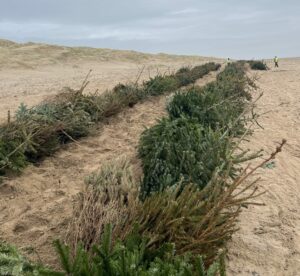This blog has been written by a member of the Newground Flood Team.
Have you thought about how, or where you will dispose of your real Christmas tree when the festive period is over? Are you aware of the positive impacts that your old Christmas tree can have on dune environments, including protecting against coastal flooding and erosion by helping to regenerate dunes?
Sand dunes are natural barriers which protect our coastal towns and villages from high tides, flooding and coastal erosion. Dunes are formed above the level of high tide when the plants that live in these salty, damp conditions trap wind-blown sand, which over time accumulates and increases the height and width of the dunes. Dunes are dynamic and constantly change due to varying wind speed and direction, rising sea levels and storm surges, that cause waves to reach higher up the beach causing erosion. The recreational activity of visitors to the dunes can also have a significant negative impact on the natural process of their formation.
Dune thatching is one method which can help preserve them, which involves covering the front of the dunes with bundles of straw, branches, plants or old Christmas trees. This technique increases sand accretion as the branches of buried plants and Christmas trees trap sediment and protect the vegetation of any new and existing dunes.
Planting Christmas trees tightly together in rows helps create a fence at the base of a dune. They are put in place where naturally occurring marram grass has been lost from trampling. Without marram grass, dunes can become flattened, as the wind blows in from the sea and blows the sand on the dune away. This can be a potentially big problem as dunes act as a natural sea defence in coastal areas and protect against flooding and erosion.
Dunes also provide a unique habitat for many protected plant and animal species, and some have a Site of Special Scientific Interest (SSSI) designation. Overtime, Christmas trees help to stabilise and build up dunes as they get buried by the windblown sand.

Image: The Flood Hub
Organisations such as the Wildlife Trust and National Trust host annual Christmas tree planting events at various location across the country. Look online or keep an eye out for further Christmas Tree planting events in your area. By recycling your old, real Christmas Trees, you can have a great positive effect on dune environments, both in terms of protecting against coastal flooding and erosion and preserving habitats.
The Fylde Sand Dunes project is a partnership between the Wildlife Trust for Lancashire, Manchester and North Merseyside, Fylde Council and Blackpool council and is funded by the Environment Agency. The project aims to encourage visitors to the dunes and educate them on their importance to flood protection and wildlife conservation. Over 80% of the sand dunes in Lancashire have been lost over the past 150 years and the project aims to improve dunes as a natural sea defence.
As part of the project, 11,000 Christmas Trees have been buried on the beach to help build up the dunes and provide an improved flood defence in Lytham, St Anne’s and Blackpool. If you would like to donate your Christmas Tree to the Fylde Sand Dunes project this year, or volunteer to help plant trees in early 2025, visit the project page here.
If you would like to donate your Christmas tree, follow the links below to find more information:
For more information on dune regeneration, please download our resource here.
To read about what The Flood Hub Team got up too when we volunteered with the project, read our blog here.
Sources used: National Trust, The Wildlife Trust for Lancashire, Manchester and North Merseyside.